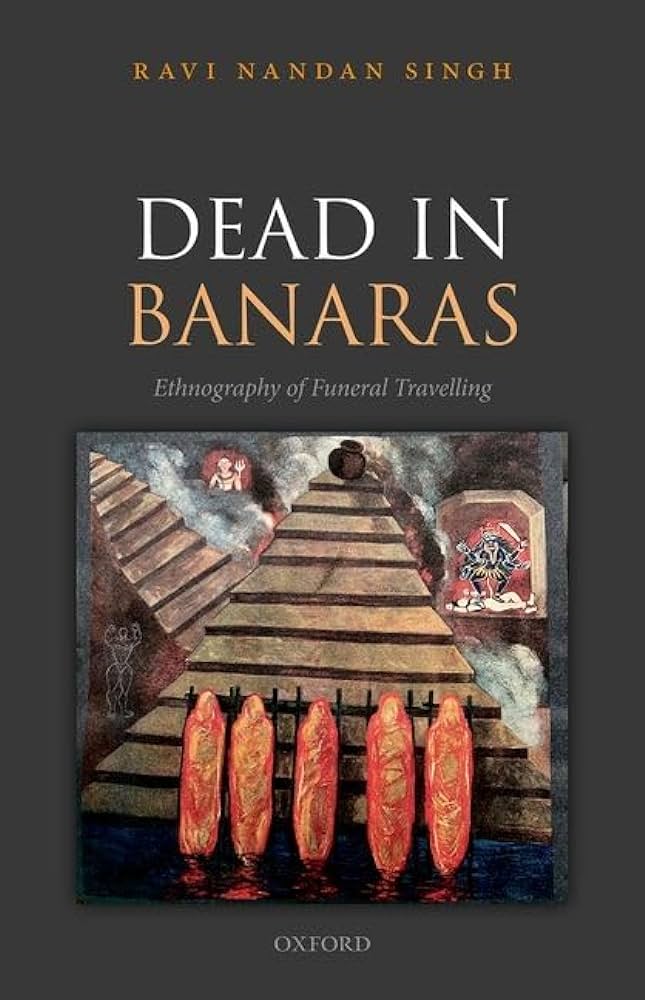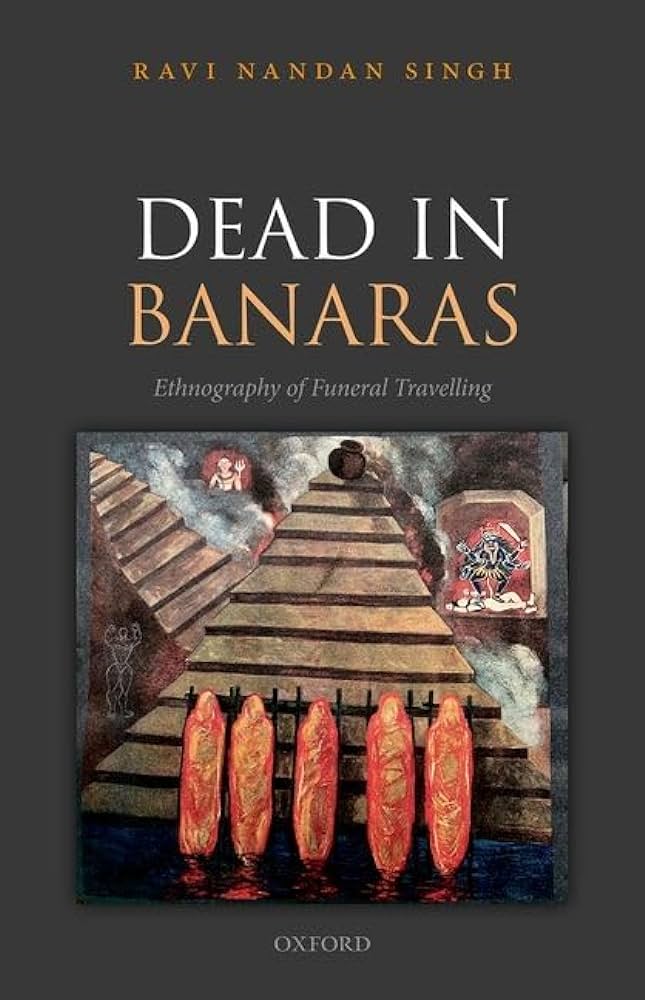
Ravi Nandan’s Dead in Benaras: Ethnography of Funeral Travelling, published by Oxford University Press in 2022, is a compelling ethnographical treatise, comprising five pit stops as chapters of varying colours and connectivity, encompassing and visualising the journey of a corpse (proximities with both dead, death and endearing) through its several stages of being. The book has the potential to make readers visit their vulnerable selves using visual imagery around deep losses, taking cues from the lens of ‘ethnographical and autobiographical’ vantage points in the words of the author. The book stays focused yet experimental in its theoretical and methodological engagement with ‘anthropological affinity to the dead’ and beyond.
The book oscillates through the weight of the classics like Forest of the Bliss (1986) by Robert Gardner and Death in Benares J Parry (1994) yet still carves its own identity emerging as a distinct genre owing to its unique craft and message. The words ‘listening to their presence’, and ‘sighing speech’ rather than the conventional interviewing as an essential guiding thought and framework, stay true to the voices from the cultural text emerging from the ashes of memorial burn and witnessing dead, deaths and thought. ‘Dead bring their own dead’ – one of the key phrases reveals the cyclical, loyalistic and mythological texture of the preferential bias towards specific ghats being the core centre of the ethnographic work.
The book is remarkable in the manner that it engages with theory and concepts with featherweight lightness. It is defined by meticulous research that addresses gaps in empirical accounts. The author skilfully illuminates the question of the ‘shift from wooden pyres to electric cremation’ for not being about competing technologies ‘but that of ethics with which the dead are tended to amidst the assemblies of funeral travellers’. The integration of utilitarian, belief-oriented and thought-oriented changes in the lifestyle are sewed together as a matter of time, a community-based understanding of self, death and belongingness. This revelation marks an extension to the research gaps in a very swift manner.
The book design with respect to its organic connectivity, and narrative arguments (intricate links within chapters) seems to be done to expand the coverage and sustain the reader’s span of thoughts and arguments systematically.
Chapter 1 provides an introductory anchor to the entire ethnography and presents a rich tapestry of the theoretical history of how death and the dead are perceived in the disciplines of anthropology, sociology and beyond. The given chapter in addition to the theoretical element also reinstates the focus and uniqueness of the given text as it digs deep into the manifestations of Ordinariness of the death and the multiplicity of the dead. The author’s father’s death (described and discussed at length in the following chapters) in the field also adds a layer to the entire understanding and helps to further the idea of how the dead and their deaths become diffused into the social in a way creating the ‘rough’ texture of the ordinary. The establishment and emphasis approach towards viewing ghats having open sensory access to the concept of circumstance (chance and intention) adds to the wide spatiality of ghats in Banaras.
Chapter 2 is about the city of Banaras, and dynamic engagement with disciplines, scholars and practices. The ethnographic enquiry does a close-quarter engagement with character(s), and breathing epistemes of the city in creative detail. There is an effort to locate the city through its various names, bound histories and how these functionalities create implications of various ranges of affinities (ritualistic, mystic, spiritualistic). The author’s answers break the common myths and clear the air on how the maintenance of differences among its meanings makes for a good case of a sheltering system. The city is being listened to, being watched over and additionally being experienced and described as symbols of lights, liberation and lore. Different names of the city and the discursive analysis come forward as a unique yet repetitive link across the contents.
Chapters 3 and 4 are narratively unified and must be read in conjunction with each other at the author’s discretion. The two middle chapters make the reader party with the agonistic and sociological (ethnographical) account of his father’s death and foregoing and ongoing rituals to make sense of the departure. It symphonises the crux, feelings, and necrological adages around the family as a unit as well as independently. It comes across a text which completes the narrative of losing a loved one (anthropology of mourning process). The recalling of essential memories, ethnography of hospital experiences, the social condition of the dead (pre and post-conditioning), the sight of anticipation, element of recursivity, the language of doctors and funeral travelling as an experience (parvah, shav-dah) all come in together in the format of ordinary from the autobiographical perspective. Funerary canvas is completed with the weaving of kinship relationships, stories and rituals from the given context. The elemental design with no headings offers the sense of present continuity of thoughts and experience. The relative absence of dense vocabulary also rings in the personal emotions to surface and sustain for longer periods. The explicit mention and reasoning of wept statements, providing agency to both dead and mournful is a beautiful example of the sociological imagination of the author. The entire text comprising of third and fourth chapter testifies the fact listed by the author that it is the memories that make and unmake the dead, extending the message to its social condition. The text provides numerous examples of the relationships having done so in the father’s case and retrospectively to other relationships.
Chapter 5 titled Conversation of Pyres is an attempt to uncover the implicit messages and symbolic exchanges (human-environment) which are both ‘quietened and heightened’ in nature. Both ‘aesthetic and ethical scaffolds of the place’ are mapped to provide a complete, all-encompassing understanding of the place. It is in this chapter, that one gets to see the pictures, theoretical mapping, commonplace observations, and bio-social convergence (artefacts and microbial facts) of its kind giving us semantic and semiotic reflections. For example, in the case of pravah and parvah. The River Ganga, Hindu symbols, and the ecstatic of the pure, purity and prevailing complete the entire academic recourse of the book as the ultimate chapter. The author argues that the interior-exterior universe is continuously remade and revised in lieu of different aesthetic changes at the ghats as differentiation ethics.
Overall, the given text provides you a chance for an immersive reading experience with increasing proximities towards, understanding death as a phenomenon and death as an entity. The book deserves a special mention with regard to the efforts gone into making the given arguments an interactive text, also to the well-grounded balance between methodological as well as theoretical threads shared throughout the book. The light thrown upon the lenses through which sociology and sociology view death either as a natural social event (life cycle ritual act) or as an inauthentic event in modernity (lack of timely medical intervention, care work, and community vigilance is substantiated throughout the text in a genealogical fashion and funerary vantage point. The author’s claims of deconstructing the ‘infrastructures of hope’ within which death finds a way to converge or shadow living is the real climactic deduction of the book.
For a familiar understanding and academic grounding of ‘death and mourning’, and ‘dead and living’ in both the mannerisms of a milestone or ordinariness the book does a fine job. Keeping in centrality the mourner, their struggles, strategies, and mannerisms to address, and receive the event and keep the dead in ‘everlasting gaze’ illuminated by grief and other emotions, the book is a good qualitative addition in serving the knit of emotions and knowledge around death in the context of the city’s cultural boundaries.
***
Snigdha Vishnoi is an Assistant Professor at the School of Liberal Studies, Dr B. R Ambedkar University, New Delhi.

[…] post Dead in Benaras: Ethnography of Funeral Travelling by Ravi Nandan Singh (2022): A Review by Snigdha … appeared first on Doing […]